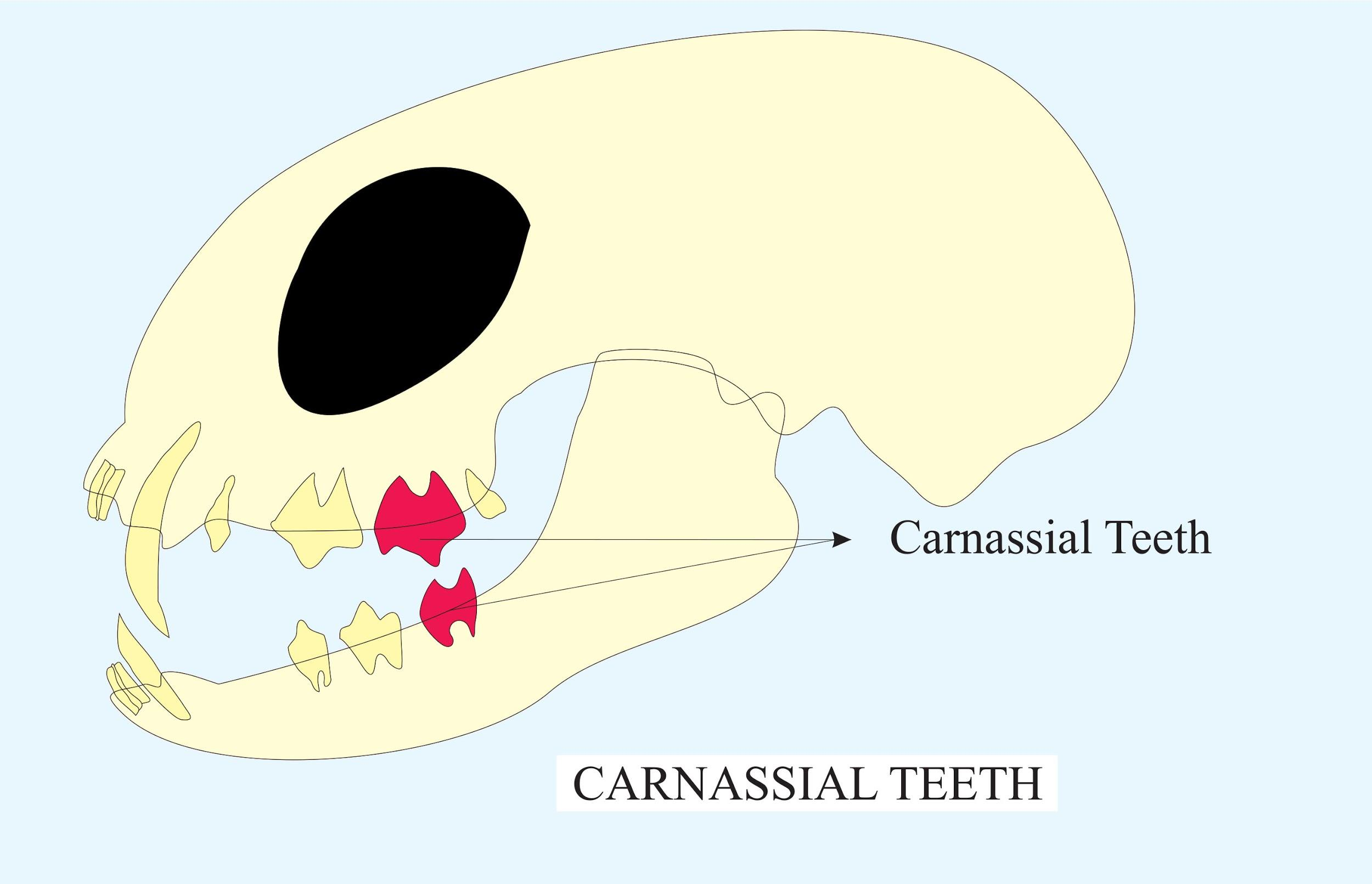
Carnassial teeth are modified for
A)Crushing
B)Grinding
C)Tearing
D)Cutting
Answer
555.3k+ views
Hint: The paired upper and lower teeth - molars and premolars and molars are Carnassials. In several groups of carnivorous mammals, the modification in the Carnassials arose separately. Mostly carnivorous animals have these teeth and humans lack these types of teeth.
Complete answer:
-The highly modified fourth upper premolars and the first lower molar teeth indicate the ancestral features that all the mammals evolved from the common lineage. These tips are adopted to tear flesh.
-These teeth (four teeth) are called; Carnassial teeth as their edges are knife-like so that they can slide past one another and when the jaw closes they act like scissors.
-The other features which are common to all the carnivorous are their restricted vertical movement of the jaw which helps the carnassial teeth to function.
-These modifications of the teeth can also be seen in a number of different mammals groups also.
Additional Information: -The dental formula of carnivorous animals is -
Incisors 3/3, Canine 1/1, Premolar 4/4, Molars 3/3, so there are a total of 44 teeth with well-developed canines.
-Many variations can be seen in the basic dental formula in some carnivorous animals due to the adaptation of animals to various diets. Many carnivorous animals have less than 44 teeth due to the reduced number of premolars, and molars.
-Many carnivorous animals like lions that eat meat from other vertebrates or invertebrates have well developed Carnassial teeth.
-The organisms that have a mixed diet of meat and vegetables, Carnassial teeth have been adapted from herbivorous to omnivorous animals. The premolars and molars are modified to grind vegetable matter.
-The few species which have adapted these teeth are Pandas to feed on bamboo, Walruses on mollusks, and crab-eating seals on krill.
So, the correct answer is,” tearing”.
Note: -The force generated by the mastication muscles allow Carnassial teeth for efficient tearing and cutting of flesh, tendon, and muscles.
-The carnival takes varies between species and the basis of length and size.
-Humans don't have Carnassial teeth.

Complete answer:
-The highly modified fourth upper premolars and the first lower molar teeth indicate the ancestral features that all the mammals evolved from the common lineage. These tips are adopted to tear flesh.
-These teeth (four teeth) are called; Carnassial teeth as their edges are knife-like so that they can slide past one another and when the jaw closes they act like scissors.
-The other features which are common to all the carnivorous are their restricted vertical movement of the jaw which helps the carnassial teeth to function.
-These modifications of the teeth can also be seen in a number of different mammals groups also.
Additional Information: -The dental formula of carnivorous animals is -
Incisors 3/3, Canine 1/1, Premolar 4/4, Molars 3/3, so there are a total of 44 teeth with well-developed canines.
-Many variations can be seen in the basic dental formula in some carnivorous animals due to the adaptation of animals to various diets. Many carnivorous animals have less than 44 teeth due to the reduced number of premolars, and molars.
-Many carnivorous animals like lions that eat meat from other vertebrates or invertebrates have well developed Carnassial teeth.
-The organisms that have a mixed diet of meat and vegetables, Carnassial teeth have been adapted from herbivorous to omnivorous animals. The premolars and molars are modified to grind vegetable matter.
-The few species which have adapted these teeth are Pandas to feed on bamboo, Walruses on mollusks, and crab-eating seals on krill.
So, the correct answer is,” tearing”.
Note: -The force generated by the mastication muscles allow Carnassial teeth for efficient tearing and cutting of flesh, tendon, and muscles.
-The carnival takes varies between species and the basis of length and size.
-Humans don't have Carnassial teeth.

Recently Updated Pages
Master Class 12 Business Studies: Engaging Questions & Answers for Success

Master Class 12 Economics: Engaging Questions & Answers for Success

Master Class 12 English: Engaging Questions & Answers for Success

Master Class 12 Maths: Engaging Questions & Answers for Success

Master Class 12 Social Science: Engaging Questions & Answers for Success

Master Class 12 Chemistry: Engaging Questions & Answers for Success

Trending doubts
Which animal has three hearts class 11 biology CBSE

1 Quintal is equal to a 110 kg b 10 kg c 100kg d 1000 class 11 physics CBSE

Explain zero factorial class 11 maths CBSE

The camels hump is made of which tissues a Skeletal class 11 biology CBSE

How do I convert ms to kmh Give an example class 11 physics CBSE

The percentage of free SO3 in oleum sample which is class 11 chemistry CBSE




